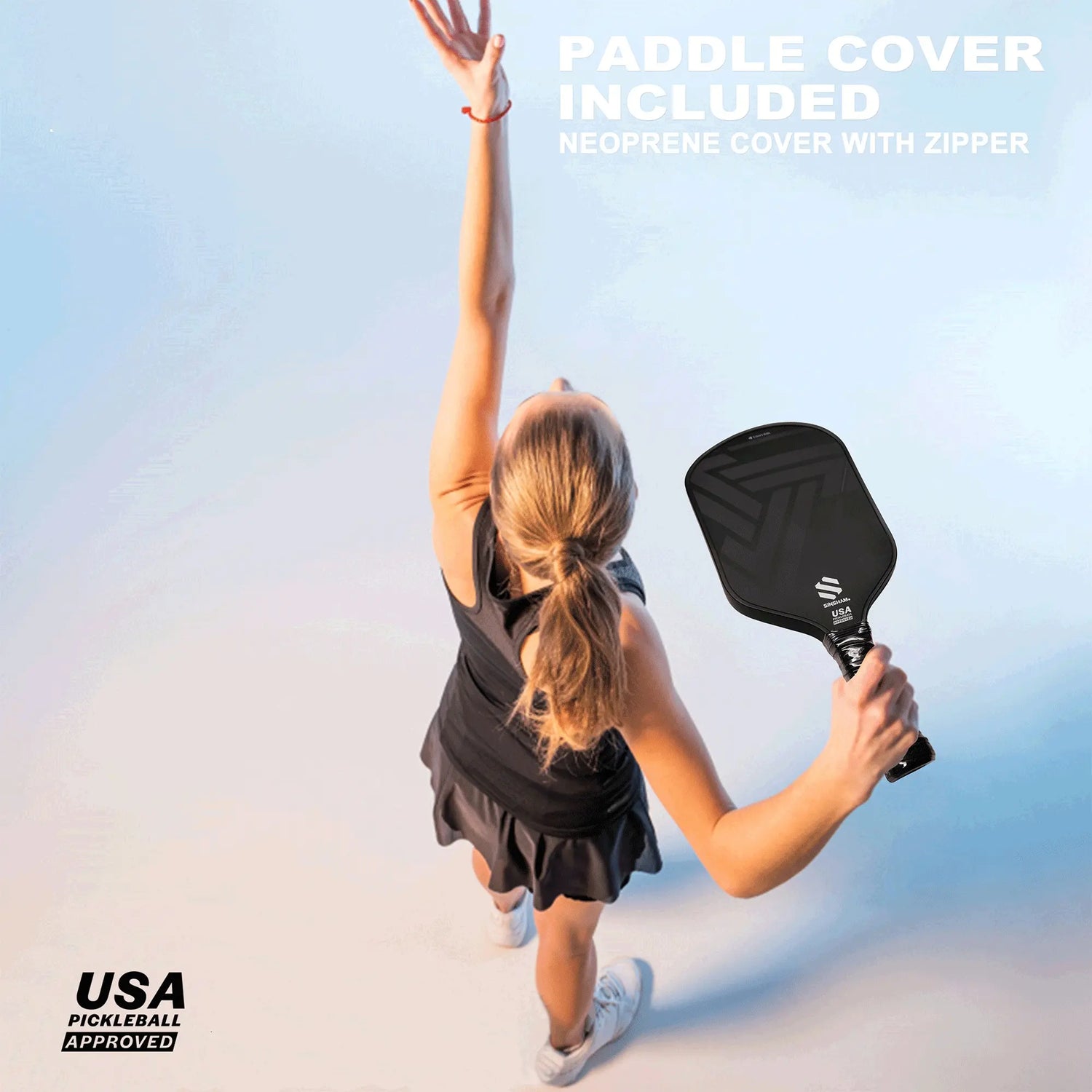
The Pro Playbook: 5 Key Pickleball Techniques to Unlock Your Potential
📘 The Ultimate Pickleball Improvement Guide Series – By Pro-Pickleball Store
The Pro Playbook: 5 Key Pickleball Techniques to Unlock Your Potential
To break through the amateur ceiling and elevate your game, mastering key pickleball techniques is essential. This guide covers five crucial skills that go beyond physical ability, focusing on strategy, control, and mental advantage to turn passive reactions into proactive control and dominate your opponents.
1. Pickleball Serve Technique: Master the Starting Point
A pro’s serve is more than getting the ball in play. It combines aggressive weight transfer with a relaxed arm and fast paddle head to produce heavy topspin. Strategy is the real secret: target opponents’ weak areas or use spin to create high bounces that set up the third-shot attack.
Example: Pro player Tom noticed his opponent’s strong forehand. He served low to the backhand with heavy topspin, forcing a defensive return and creating a perfect third-shot attack opportunity.
2. Kitchen Line Progression: Dynamic Third-Shot Strategy
Amateurs see the third shot as a way to reach the kitchen; pros treat it as a tactical system. A "drive-to-drop" strategy uses a solid drive to push opponents back, followed by a soft drop to advance. Quality drop shots rely on soft hands for depth and low trajectory, while resets from mid-court create second chances to maintain pressure.
Example: Player Emily combined a drive, a deep drop, and a mid-court reset to control game rhythm and dominate her opponent at the kitchen line.

3. Pickleball Dinks: Psychological Pressure on Opponents
Dinking isn’t just defensive. Pros use spin variation, tempo changes, and sharp angles to disrupt opponents. Aggressive body language after a dink signals a threat of the next volley, creating mental pressure.
Example: Player Jack mixed slow slice dinks with quick-tempo dinks and angled shots, forcing his opponent to cover the entire court and giving him a strategic edge.
4. Counterattack at the Net: Build a Solid Defense
Handling fast shots at the net requires active paddle tracking, a stable lower body, and short, explosive movements. This stance deters aggressive opponents and increases their error rate.
Example: Player David used precise paddle tracking and explosive movements to control high-speed volleys. His opponents became hesitant, making more errors during rallies.
5. Attacking Lob: Offensive Control from Defense
Pros turn defensive lobs into disguised attacks by positioning early, using fakes, and hiding paddle intentions. This makes opponents reluctant to attack high balls and keeps them on the defensive.
Example: Player Lucy combined early positioning, low paddle hiding, and quick fakes to force opponents into defensive play, controlling match tempo.
🎯 Recommended Pickleball Paddles for Intermediate & Advanced Players
To truly master the techniques in this guide, having the right paddle is crucial. Here’s our recommendation based on skill level:
Intermediate Players
These paddles offer a balanced blend of control and power, helping you develop consistency while still allowing for aggressive shots. Ideal for players who are refining their third-shot drops, dinks, and kitchen positioning. They provide confidence in both defensive and offensive plays as you transition from amateur to advanced skill levels.
🚀 Intermediate Paddles – Step up your game
Advanced Players
Designed for players who already have solid fundamentals, these paddles maximize precision, touch, and responsiveness. Perfect for executing advanced strategies like combination returns, attacking lobs, and high-pressure dinks. Lightweight yet stable, they allow rapid adjustments and superior court feel, giving you a competitive edge in high-level singles or doubles matches.
🎁 Advanced Paddles – Maximum performance
Training & Reaction Tools
Complement your paddle with training aids like wall rebound balls, paddle trainers, or bounce-back devices. These simulate high-speed or spin-heavy shots, helping you sharpen reflexes, footwork, and timing for real match situations.
FAQs About Advanced Pickleball Techniques
Q1: How do I improve my third-shot drop in singles?
A: Focus on soft hands, depth control, and consistent follow-through. Use drills to simulate match pressure for accuracy.
Q2: What’s the best way to practice dinks effectively?
A: Mix tempo, spin, and angle variations in drills. Aim for control and consistency under pressure.
Q3: Which paddle is best for mastering third-shot attacks?
A: High-control paddles are recommended for precision, while balanced paddles help handle fast volleys and drives.
Q4: How can I train my counterattack skills?
A: Practice active paddle tracking, explosive footwork, and anticipation drills. Combine with reaction tools for maximum improvement.
Conclusion
Mastering these five pickleball techniques—from serve strategy to attacking lobs—requires systematic practice, mental focus, and the right paddle. By combining targeted drills, tactical awareness, and high-quality equipment from Pro-Pickleball Store, you can unlock your full potential and dominate singles and doubles play.
Related Articles
📚 Explore more pro-level strategies to enhance your pickleball game:
- Learn advanced pickleball shots like the Erne and Bert
- Practical tips to improve your pickleball game steadily
- Why your return of serve can dictate the pickleball match
- Tactics for winning even with a less experienced partner
- Pickleball Spin Techniques & Analysis: Unlock the Winning Code
- Pickleball Singles Strategies: Three Tactics and Four Tips
- Pickleball for Beginners: Master 5 Essential Shots
- Pickleball Shot Placement Guide: Court Control & Winning Strategies
- Master Pickleball Dinks: 5 Proven Strategies to Control the Game
- Pickleball Return Techniques: Topspin vs Slice
- Beginner’s Guide to Pickleball Tournaments | 4 Winning Strategies
- Smarter Pickleball Training: Drills to Break Your Plateau
- High-Speed Pickleball Serve Returns: Win More Singles Points